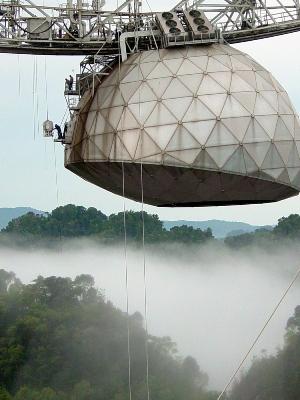The radio telescope in Arecibo, Puerto Rico, the world's largest and most sensitive radio telescope dish is about to get a lot more sensitive
Avi Blizovsky

Photo: Morning mists cover the hills of Puerto Rico, workers prepare to bring the Alpha unit (suspended by cables on the left) into the Gregorian dome of the Arecibo telescope. Photo: Tony Acquado, Arisbo Observatory, rights reserved to Cornell University.
Direct link to this page:
https://www.hayadan.org.il/areciboupgrade.html
The radio telescope in Arecibo, Puerto Rico, the world's largest and most sensitive radio telescope dish is about to become much more sensitive. On Wednesday, April 21, the telescope got a new eye on the sky, which will turn the giant dish operated by Cornell University for the National Science Foundation into the equivalent of a seven-pixel radio camera.
The new addition to the telescope was dragged 150 meters above the receiving plate with a diameter of 305 meters. The device, the size of a washing machine, was raised for 30 minutes to a platform inside the Gregorian dome, where it cooled and connected to a system of optical fibers that led to high-speed signal processors.
The new device is called ALFA - acronym for Arecibo L-Band Feed Array and is actually a camera that takes radio pictures of the sky. Alpha will produce large-scale surveys of the sky with very high sensitivity, allowing astronomers to collect data 7 times faster than the current situation.
The Alpha Colt was built by a group of researchers from Australia, from the British Commonwealth of Scientific and Industrial Research, under contract for the Center for Astronomy and Ionosphere (NAIC) at Cornell in Ithaca, New York. Alpha's development was also reviewed by the observatory's technical staff. The rest of Alpha's systems, including the ultra-fast processing machines, are under development by NAIC.
Traditionally, radio telescopes are limited to observing one point - one pixel - in the sky at a given time. Pictures of the sky were built point by point. However, Alpha allows the telescope to see seven points - seven pixels - in the sky at once, reducing the time needed to perform surveys of the entire sky. Steve Torchinsky, director of the Alpha project at the Arecibo Observatory, said that the new instrument will make it possible to find many new pulsars (compressed stars that rapidly rotate around themselves) and will improve the chances of finding rare star systems such as pulsars orbiting black holes.
The telescope will also map the neutral hydrogen gas in our galaxy, as well as in other galaxies. Hydrogen is the most common element in the world. "A wide variety of science missions are planned for Alpha," Turczynski said. "The huge collection area in Arecibo will be particularly suitable for the study of pulsars."
NAIC's contract to CSIRO to build Alpha follows the success of the "multi-beam" systems designed and built at the radio telescope at Mitzpe Parkes in eastern Australia. The devices doubled the power of the Parkes telescope 13 times and thus made it for the first time capable of searching the entire sky for pale and hidden galaxies.
For information on the Science Daily website
Astronomer
https://www.hayadan.org.il/BuildaGate4/general2/data_card.php?Cat=~~~820065125~~~249&SiteName=hayadan
